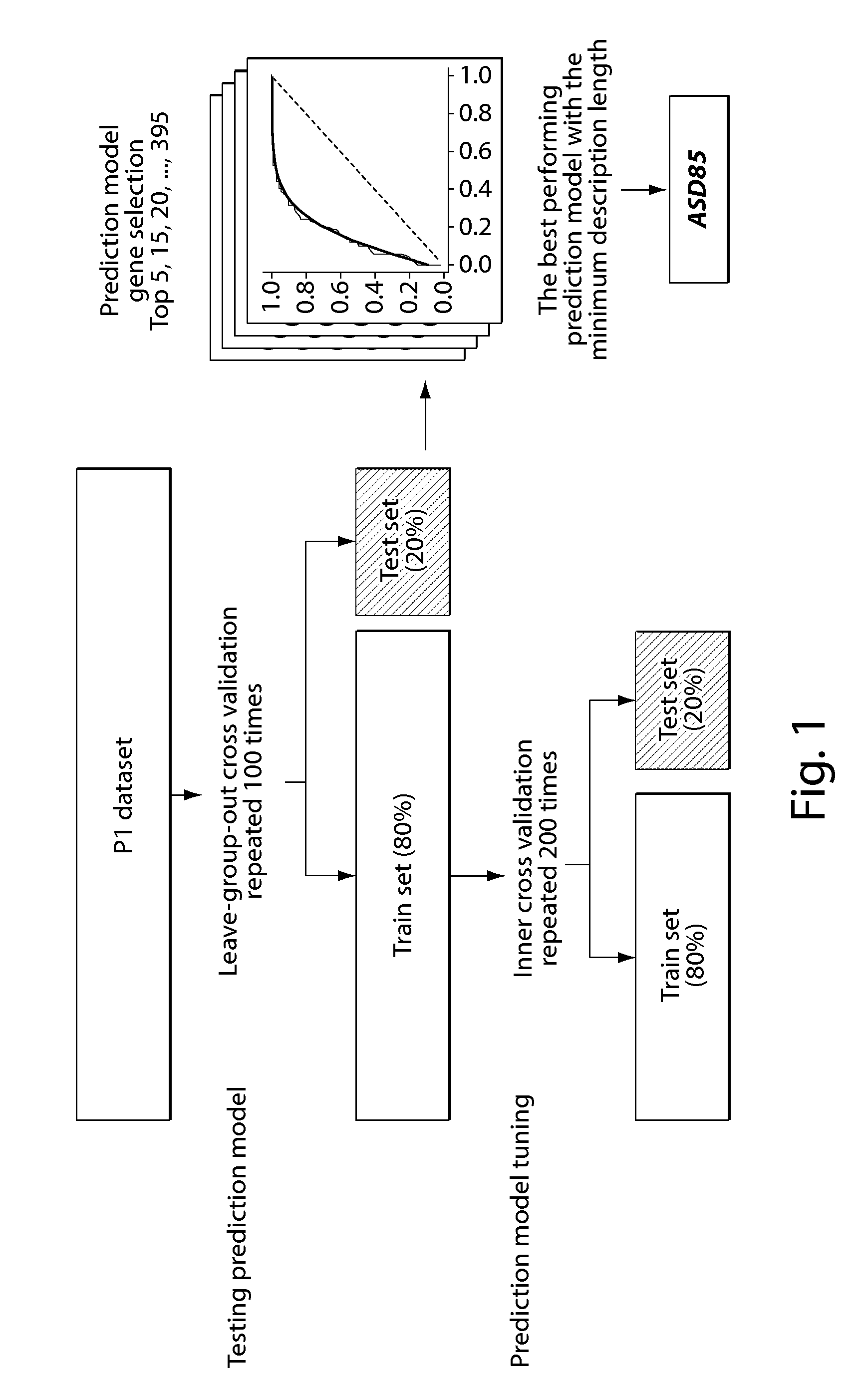Methods and compositions for characterizing autism spectrum disorder based on gene expression patterns
a technology of gene expression and composition, applied in the field of methods and compositions for characterizing autism spectrum disorder based on gene expression patterns, can solve the problems of significant debate regarding the prognostic value and accuracy of existing instruments, and achieve the effect of assessing the efficacy of dosag
- Summary
- Abstract
- Description
- Claims
- Application Information
AI Technical Summary
Benefits of technology
Problems solved by technology
Method used
Image
Examples
example 1
Materials and Methods
Blood Gene Expression Profiling
[0076]Gene expression profiles of P1 were prepared using Affymetrix HG-U133 Plus 2.0 (U133p2) and those of P2 were profiled using Affymetrix Gene 1.0 ST (GeneST) arrays (Affymetrix, CA). Within the P1 data set, RNAs from 39 ASD and 12 control samples were isolated directly from whole blood using the RiboPure Blood Kit (Ambion). For all other blood samples, total RNA was extracted from 2.5 ml of whole venous blood using the PAX gene Blood RNA System (PreAnalytix). Quality and quantity of these RNAs was assessed using the Nanodrop spectrophotometer (Thermo Scientific) and Bioanalyzer System (Agilent). Fragmented cRNA was hybridized to the appropriate Affymetrix array and scanned on an Affymetrix GeneChip scanner 3000. cRNA from both affected and normal control population groups was prepared in batches consisting of a randomized assortment of the two comparison groups.
[0077]The gene expression levels were calculate...
example 2
Gene Expression Signature Assessment
[0085]ASD patients were recruited. Study inclusion criteria comprised a clinical diagnosis of ASD by DSM-IV-TR criteria and an age >24 months. Patients with ASD recruited for this study have underwent diagnostic assessment, using ADOS and ADI-R, as well as clinical testing including cognitive testing, language measures, medical history, height and weight, head circumference, and behavioral questionnaires. Two independently collected data sets (hereafter P1 and P2) consisted of 66 and 104 ASD individuals. Patients with known syndromic disorders such as fragile X mental retardation, tuberous sclerosis, Landau-Kleffner syndrome, and Klinefelter syndrome were not included in this study.
[0086]A total of 115 controls were enrolled concurrently. Certain control patients were identified as healthy children with idiopathic short stature, including genetic short stature and constitutional delay of growth, and were having clinical blood draws. Clinical blood...
example 3
Gene Expression Signature Assessment
[0105]This example provides the results of a blood transcriptome analysis that aims to identify differences in 170 ASD and 115 age / sex-matched controls and to evaluate the utility of gene expression profiling as a tool to aid in the diagnosis of ASD. Differentially expressed genes were enriched for the neurotrophin signaling, long-term potentiation / depression, and notch signaling pathways, among other pathways. A 55-gene prediction model was developed, using a cross-validation strategy, on a sample cohort of 66 male ASD and 33 age-matched male controls (referred to in Example 3 as P1*). Subsequently, 104 ASD and 82 controls were recruited and used as a validation set (referred to in Example 3 as P2*). This 55-gene expression signature achieved 68% classification accuracy with the validation cohort (area under the receiver operating characteristic curve (AUC): 0.70 [95% confidence interval [CI]: 0.62-0.77]). The prediction model was built and train...
PUM
| Property | Measurement | Unit |
|---|---|---|
| autism spectrum disorder | aaaaa | aaaaa |
| spectrum | aaaaa | aaaaa |
| 's disorder | aaaaa | aaaaa |
Abstract
Description
Claims
Application Information
 Login to View More
Login to View More - R&D
- Intellectual Property
- Life Sciences
- Materials
- Tech Scout
- Unparalleled Data Quality
- Higher Quality Content
- 60% Fewer Hallucinations
Browse by: Latest US Patents, China's latest patents, Technical Efficacy Thesaurus, Application Domain, Technology Topic, Popular Technical Reports.
© 2025 PatSnap. All rights reserved.Legal|Privacy policy|Modern Slavery Act Transparency Statement|Sitemap|About US| Contact US: help@patsnap.com



